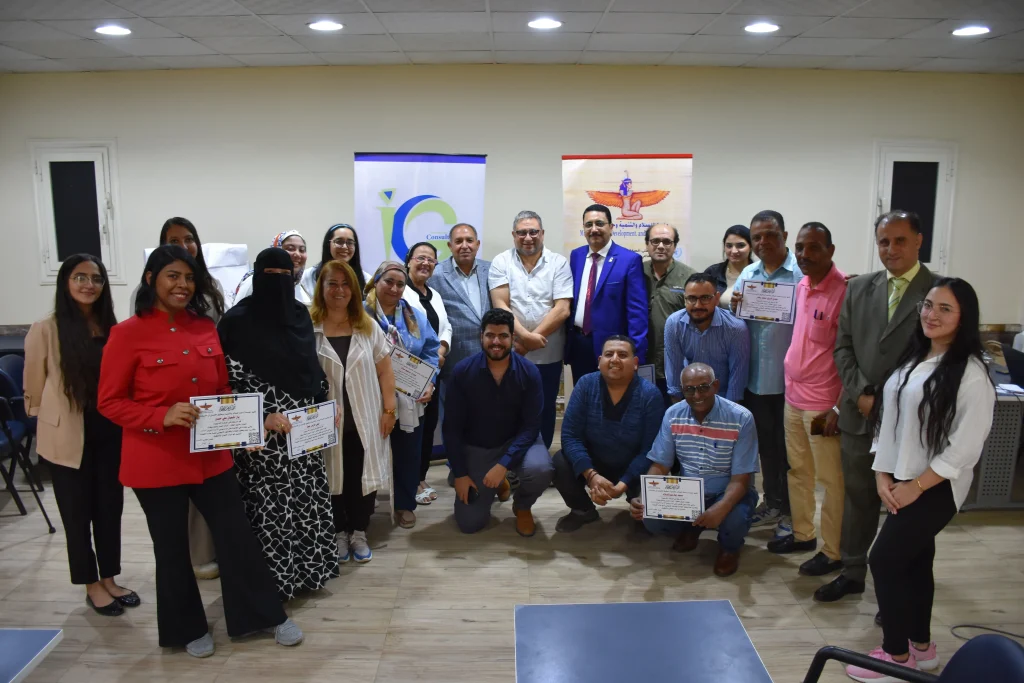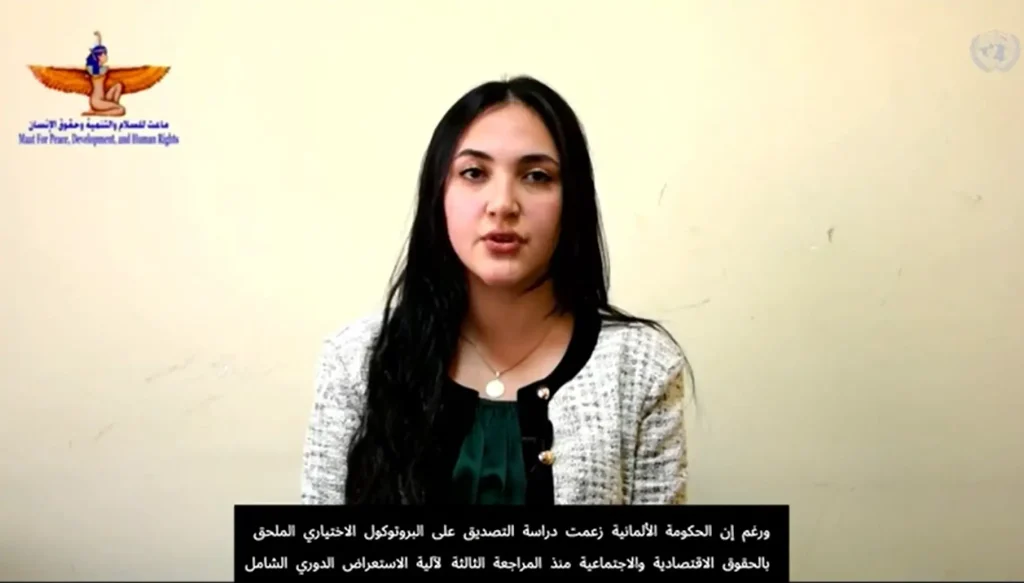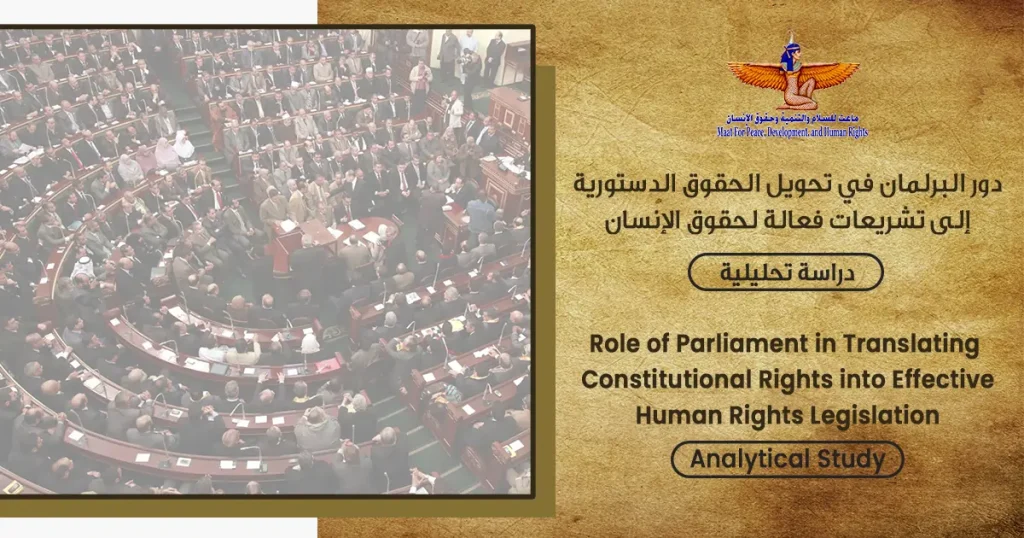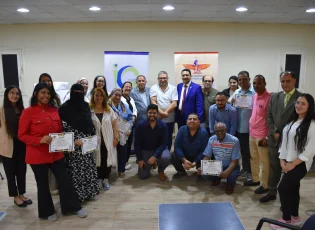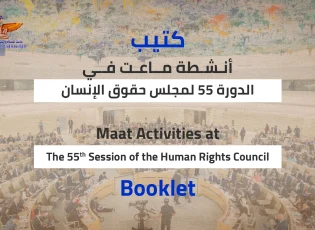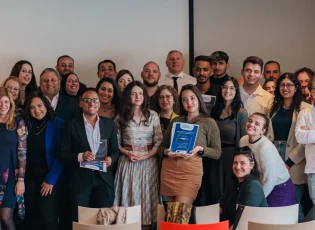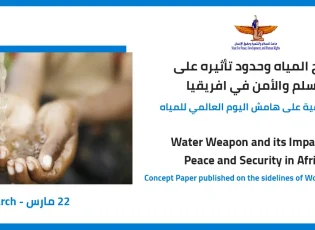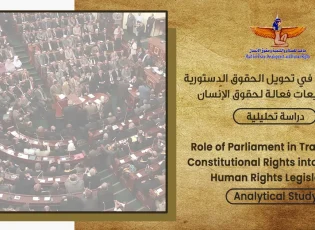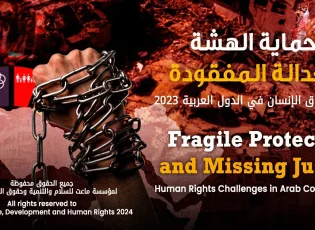Homeless children - a new vision to cure the phenomenon
Policy Paper
Issued it
Public Policy Analysis and Human Rights Unit
Affiliate Foundation
, Maat for Peace, Development, and Human Rights
Under a project
The Universal Periodic Review as a Tool to Improve Public Policies during the Transition
“This release was implemented with the help of the European Union. The content of this publication is the responsibility of the Maat Foundation for Peace, Development and Human Rights and can in no way be considered a reflection of the vision of the European Union.
Introduction: -
 The phenomenon of homeless children is one of the most important social phenomena that draw attention to every follower of the social and political conditions in Egypt, since the beginning of the third millennium, especially in the capital Cairo and the capitals of the governorates in light of the difficult economic and social factors that Egypt is going through, which prompted a large number of children as a result These factors lead to going out to the street, and according to most studies that have been formulated on this topic, most of these children are from families that fall below the extreme poverty line.
The phenomenon of homeless children is one of the most important social phenomena that draw attention to every follower of the social and political conditions in Egypt, since the beginning of the third millennium, especially in the capital Cairo and the capitals of the governorates in light of the difficult economic and social factors that Egypt is going through, which prompted a large number of children as a result These factors lead to going out to the street, and according to most studies that have been formulated on this topic, most of these children are from families that fall below the extreme poverty line.
Within the framework of the “Public Policy Analysis and Human Rights Unit” interest in the Maat Foundation for Peace, Development and Human Rights with the recommendations that were made to Egypt in light of the universal periodic review and the Egyptian government's position on the recommendations and in light of the institution’s implementation of the “Universal Periodic Review as a tool for improving public policies during the transitional phase”, Funded by the European Union during 2016-2017, the Foundation has focused on shedding light on that issue through a paper explaining the most important problems of the phenomenon of homeless children, with the aim of reducing that phenomenon.
The paper dealt with this phenomenon by presentation and analysis in multiple axes, which included in the first axis the definition of children, the concept and the causes of the problem of homeless children, then in the second axis it moved to present the consequences of that phenomenon, and in the third axis the paper talked about the human rights, constitutional and legal frameworks of the phenomenon with a presentation Fast for the most important efforts made to eradicate this phenomenon, then in the fourth axis the paper presented the most important legal problems and the institution that helps spread the phenomenon, and in the last axis the paper concluded with a set of recommendations related to some legislative amendments and the most important institutional reforms.
The first axis: introducing children to the concept of the problem and its causes
- Child definition: -
International law considers that a child is every person under the age of eighteen, and therefore anyone under this age is entitled to special aspects of protection when brought to trial. The United Nations Rules for the Protection of Juveniles Deprived of Liberty defined a juvenile as “every person under the age of eighteen,” while the “Convention on the Rights of the Child” defines a child as every person under eighteen unless the enactment of national law specifies another age for reaching adulthood. Each country has the right to set the age of majority, but it should not deviate significantly from international standards
- Defining homeless children: -
Street children are considered to be males or females under the age of eighteen years who live, sleep, eat and play in the streets. They do not work or work in an informal and unauthorized manner and their relationship with their families is often cut off. The definition is also related to those children who are homeless and sell on the street or who beg or They sell sweets, wipe car windows, or similar occupations on traffic lights, on transportation, or in streets and public squares.
- Reasons for the spread of the phenomenon of homeless children: -
The reasons for the spread of the phenomenon of homeless children are many, especially after Egypt witnessed in recent years rapid changes that included various aspects of life in society. The following are the most important causes of the spread of the phenomenon: -
- Poverty: Poverty is one of the most important factors in the spread of the phenomenon of homeless children. It often leads to the family’s inability to take care of its children and cover their basic needs in terms of food, drink, clothing and treatment other than education expenses, so the child does not find anything but the street, and sometimes under economic pressure the father expels his son To get out on the street against his will.
- Family conditions: Family conditions and conditions play an important and fundamental role in the spread of the phenomenon of street children, considering that the reference group for the child who is his personality, and homeless children often belong to family patterns of low economic and social level that usually suffer from low income, education, educational awareness, and deficiencies in care. The social and health of the child, in addition to other family factors that help to understand the phenomenon, including the disintegration of families, either through divorce, abandonment, or the death of one of the parents and the other being married to a person who is not faithful to the child, which leads to the child fleeing to the street. When parents are unable to direct them and meet their needs, and with the high density of the house, children sleep with parents in one room. One of the factors that children flee to the streets as a result of their feeling that their parents are unable to fulfill their demands. The death of one or both parents is considered a reason for weak supervision over children and then their deviation or exit to the street, as well as residing with relatives as a result of orphans, rifting prisoners, or the absence of the father or parents to work with the weakness of relatives’s control over children, one of the reasons for their escape to the street. It is also considered that the fathers sometimes distinguishing between children within the same family generates jealousy among them and may push children to flee to the street. Children may also resort to running away from home as a result of the father or mother doing a perverted act, which causes children to deviate and professionalize the work itself, especially as bad friends invite children, especially at the beginning of adulthood, to go out to the street to work, earn and imitate adults.
- The growth and spread of informal settlements that represent the primary and primary foci of reception for street children, as unlicensed workshops and factories that employ these children in multiple jobs are spread in these areas at little cost, taking advantage of their need for money or shelter.
- Leakage from education is also considered one of the effective reasons for the increase in the phenomenon of homeless children, especially that degrades poverty, which pushes groups or groups of children whose social maturity is not yet complete, making them easy prey for moral deviations, so they become a tool for demolition in any organized gangs and then they are separated from Their families are heading to live on the street without shelter due to the large number of family members with their decision or the lack of a family breadwinner.
- The lack of adequate care homes to accommodate children and the lack of qualified workers to deal with children in them is one of the most important factors that lead to the increase of the phenomenon, according to the director of the Juvenile Welfare Investigation Department in Cairo in one of the press interviews ([1]) In which he confirmed that the existing institutions and social care homes include a large number of employees who are not qualified to deal with children, and do not provide them with advanced rehabilitation programs, and that leads to the acquisition of children who enter them to acquire new criminal methods. He also stressed that Egypt as a whole does not have a single advanced-style nursing home, or its role to the fullest, even those equipped with high costs that operate for their own purposes, and care homes are in a deplorable state, as a result of the absence of the primary role for those in charge of reform and rehabilitation programs for children Within those institutions. Which pushes children to return to the street, where absolute freedom without restrictions, dependence on others, begging to provide a living, and even the practice of prostitution sometimes, especially children in their teens.
- Number of homeless children in Egypt: -
The lack of a comprehensive official inventory of the phenomenon of homeless children is considered one of the most important obstacles to treating the phenomenon, and despite the announcement by the National Center for Social and Criminal Research, in cooperation with the Ministry of Social Security, on the number of homeless children in Egypt, it was not according to a comprehensive survey and does not reflect the real reality of the crisis in terms of number and classification, Street children were concentrated in the governorates of Egypt, where the center followed the comprehensive survey approach by taking a single shot that lasted only 19 hours in 27 governorates at the same time with 3800 researchers, in which the center indicated that there are 16 thousand and 19 children concentrated in 2558 regions nationwide, and there are in Cairo 4487 children in 703 areas, and in Giza, 1658 children in 187 regions, and in Qalyubia, 1342 children in 197 regions, and in Minya, 1061 children in 115 regions, and there are 927 children in Sharkia divided into 181 regions, and in Assiut 793 children divided into 78 regions. In Alexandria, there are 742 children in 97 regions, while Menoufia has 614 children in 57 regions, and in Suez, there are 594 children in 57 regions, and in Beni Suef there are 521 children in 125 regions, and in Dakahlia there are 410 children divided into 92 regions, and in Kafr El Sheikh exist 396 children in 84 districts, and in Port Said 381 children concentrated in 104 regions, and in Aswan 368 children in 63 regions, and in Gharbia 349 children in 73 districts, while 250 children in Qena are concentrated in 64 districts, and in Sohag 214 children in 49 districts As for Luxor, it has 193 children in 21 districts, and in Beheira 181 children in 73 regions, and in Damietta 158 children in 48 regions, and in the Red Sea, 134 children are concentrated in 16 districts, and in Fayoum 102 children in 33 regions, and in Ismailia 63 children in 24 A region, and in North Sinai there are 70 children in 9 regions, and in South Sinai there are 11 children divided into 7 regions. ([2]).
The study showed that 88% of them are concentrated in urban areas and 12% in villages, and the percentage of males is 83% and females are 17%, 86.9% of them are healthy, while the rest is distributed among the various disabilities.
The study also indicates that Cairo is the city in which the homeless are most prevalent, as its streets shelter 31.6% of the total number of homeless people in all of Egypt, which amounts to nearly two million children, followed by Port Said governorate with a homeless rate of 16.8% ([3])
Despite this official report issued by the Ministry of Solidarity, another report by UNICEF confirms that street children are close to 2 million children in 2014. ([4]) This indicates the conflict of official reports with reports of international institutions.
The second axis: the consequences of the spread of the phenomenon
- The spread of crime against children
In an investigation published for Nisf Al Dunya magazine ([5]) In it, it confirmed the occurrence of more than eighteen thousand crimes related to homeless children in one year only against each other and against citizens and state institutions, including murders, kidnappings, rape, sexual harassment and others, and although the phenomenon of street children is considered an ancient phenomenon in Egyptian society, but The majority of Egyptians began to feel it to a large degree during the past ten years, and the Egyptians woke up to it, especially when they woke up to the recent incident of al-Turbini, who was dubbed the serial killer of homeless children (street children) and who was involved in the sexual abuse and killing of about 40 children.
The homeless children are also exposed to the attraction of organized criminal groups for them, and their taking easy and cheap tools for illegal activities. They may use tools in promoting and distributing contraband, especially drugs of all kinds, or immoral acts.
- The use of homeless children by human trafficking and organ transplant gangs
The homeless children are exposed to the exploitation of human trafficking gangs in all their forms and at all levels, as these children fall into trafficking operations by others in the distribution, packaging or provision of drugs for abuse, and most of them cannot stay away from activity either because of their addiction or because of coercion and fear of punishment by the trafficker.
It is also considered one of the most important and dangerous forms of human trafficking is the use of homeless children in prostitution, and it is one of the forms of human trafficking that is very profitable for gangs that shelter these children, as the child can be exploited in sexual trade, without concern for the child's humanity and without concern for his life.
Some gangs sometimes use children to transfer organs, especially the cornea of the eye - and then the child is then used to beg, using his visual impairment - under the pressure of coercion or the threat that these gangs exert on children, as the Ministry of Interior announced some time ago about Its arrest of a group of criminals who use children in continuous blood donation operations and sell it, which also falls under human trafficking.
The homeless children under the pressure of want are also forced to work in scavenging garbage, looking for things that are sold to garbage dealers, or working as a shoe-sweeper for an unfair payment.
Al-Badeel website also published a press investigation ([6]The homeless children have been subjected to kidnappings as they are valuable catch for the gangs, which see them as just street children who do not have families, and no one will ask them in their absence, to be deported out of Egypt illegally through international gangs that exploit them in the drug trade and begging even trafficking in Their human organs.
- The increase in the phenomenon of begging
The phenomenon of begging among these children is spread due to the lack of work opportunities for them, so they are forced to beg to secure a living if they are not blackmailed by gangs that attract homeless children, exploiting their need for a place to shelter them.
Begging is one of the most common methods in which children are exploited and they may resort to it with individual efforts, or by joining professionals in begging, and the child who has a great ability to act and draw compassion from donors excels in it. When children join under the care of those who exploit them in begging, there are several measures taken by the criminal To spread fear in the souls of children, including that one of them is severely punished as a result of hiding part of the proceeds of begging, and the matter may amount to causing him a disability, or sexually assaulting him, and after controlling the child completely, protection is provided to him, whether by alerting him to the police or whoever attacks him. Older than him, along with providing drugs and a shelter.
- Delinquency of homeless children
The law considers the child vulnerable to delinquency if he is found a beggar, does not have a stable place of residence, mixes with those who are disinterested and who are vulnerable to delinquency, or he keeps running away from schools and educational institutes, or if he is badly conducting a rogue from the authority of his father, or if he does not have a legitimate means of earning and living.
The majority of homeless children are exposed to easy and rapid instigation of criminal acts as a result of their weakness or lack of education, with weak religious beliefs and the extent of their feeling of inferiority. What makes them easy hunting for use in various types of crimes, including drug trafficking, house theft, prostitution, begging, and training them for pickpocketing. Working in the drug trade is one of the jobs in which children excel and get into work as if they are receiving training, so the child begins to work as a "nadouji" in the beginning, which is important. It fits him perfectly as a child does not arouse suspicion while he plays with his friends, after training him in the power of observation. When he suspects any stranger or notices police cars, he sounds a whistle or imitates a bird's sound or a word that children circulate quickly, so you reach the merchant to take his caution([7]). .
Children are also exploited in theft crimes, where they are used to their small size and rapid movement by entering the place to be stolen through a small window or a sail, and his role is limited at the beginning to open the place for the big thief and enter him, then after he is trained in the speed of movement and begins to reach places Money and jewelry after breaking drawers and doors. A terrifying future awaits him after that, in which he will turn with the passage of days into a professional thief.
- Diseases spread among homeless children
Many homeless children are exposed to many health risks during their daily lives as they lack protection, as they often work without obtaining any kind of social insurance or even employment contracts, which puts them in most cases vulnerable to extortion and violence on the part of those who work for them or those who work for them. Public in the street, and this exposes them to many accidents and diseases. It is possible to see these children most of the time barefoot in the streets, and sometimes large parts of their bodies are bare, even in winter, and some of them stand on piles of garbage looking for food for themselves, and this exposes them to many injuries, wounds and diseases resulting from pollution. ([8]) It is one of the most important diseases that children suffer from
- Food poisoning: It occurs to children as a result of eating spoiled food that has expired for human use, but homeless children collect it from the garbage and eat it.
- Scabies: Many homeless children have scabies as a natural result of not observing the rules of personal hygiene and also continuing to wear the same clothes for long periods.
- Typhoid: It is a common disease among street children as a result of eating unwashed vegetables that street children collect from the garbage or because of eating a meal on which flies collect.
- Malaria: As a result, street children are exposed to huge amounts of the mosquitoes that transmit malaria while they sleep in public parks at night without covers to protect them.
- Anemia: Street children get anemia as a result of the lack of variety and the meals they eat contain all the necessary requirements for building the body as a result of their poverty and lack of money.
- Constant coughing and fatigue in the chest: This is a result of street children inhaling car exhaust because they are exposed to it all day, in addition to smoking cigarettes and being exposed to colds in the winter as a result of staying in the street.
- The occurrence of homeless children in conflict with the law
Homeless children are the most vulnerable to violence and attacks of all kinds, due to their presence on the edge of society and their dependence on marginal livelihood activities such as begging, cleaning work and petty theft, which puts them in constant contact with police personnel and thus increases their exposure to violence. Children who are homeless as a result of the harsh conditions they are exposed to are in constant conflict with the law, whether as victims or witnesses, as children suspected or accused of committing a crime are often detained for various reasons such as vagrancy, begging, theft or selling drugs, and they may be detained with adult prisoners because they are not The availability of special places of detention for children in all police stations and stations, which sometimes exposes them to physical, psychological and sexual abuse by adult detainees.
Although the law defines the means to protect these children, there is obstinacy and arrogance on the part of some policemen, especially in confronting them, whether during their arrest by using a stick and batons to hit them while being chased, or during their drive to and from the police station or station and placing iron restrictions in their hands.
The third axis: the legal, constitutional and legal framework, and the state's efforts
Review and international charters
- Declaration of the Rights of the Child ([9](.
On 20 November 1959, the Social, Humanitarian and Cooperative Committee of the United Nations General Assembly endorsed the Universal Declaration of the Rights of the Child. Its preamble stipulated that the child could enjoy a happy childhood in which he would enjoy his natural rights and freedom, and on the other hand, it called on fathers, mothers, men, women, voluntary organizations, local authorities and national governments to recognize these rights and strive to ensure their observance through legislative and non-legislative measures that are gradually taken and in accordance with the ten principles stated in the declaration. From which we show what we are interested in in this paper: -
- The child must in all circumstances be among the first to receive protection and relief.
- The child should enjoy special protection and be granted by legislation and other means, opportunities and facilities necessary to enable his physical, mental, moral, spiritual and social development in a healthy and natural way in an atmosphere of freedom and dignity, and his supreme interest shall be the primary consideration in drafting laws for this purpose.
- The child must enjoy protection from all forms of cruelty and exploitation, and it is prohibited to trade in him in any form, and it is not permissible to use the child before reaching the appropriate minimum age, and it is prohibited in all cases to induce him to work or leave him to work in any profession or profession that leads to his health or education or impedes his growth Physical, mental or congenital.
- Convention on the Rights of the Child ([10]).
This convention constitutes the universal legal framework that aims to provide protection for the best interest of children, regardless of the circumstances, and to take appropriate measures to ensure their development in a healthy and natural manner on the physical, mental, moral and social levels, without any discrimination and in full respect for their freedom and dignity, as the agreement states in some of its provisions: -
- Article 16: It is not permissible for any arbitrary or unlawful exposure to a child in his private life, family, home, or correspondence, nor any unlawful prejudice to his honor or reputation. The child has the right to be protected by law from such interference or attacks.
- Article 24: States Parties shall take all effective and appropriate measures with a view to abolishing traditional practices harmful to the health of children.
- Article 28: State Parties shall take all appropriate measures to ensure that the school system is administered in a manner consistent with the human dignity of the child and consistent with this convention.
- Article 32: States parties recognize the right of the child to be protected from economic exploitation and from performing any work that is likely to be dangerous or to impede the child's education, or to be harmful to the child's health or physical, mental, spiritual, moral, or social development.
- Article 33: States Parties shall take all appropriate measures, including legislative, administrative, social and educational measures, to prevent children from illicit use of narcotic drugs and psychotropic substances ...
- Article 34: States Parties undertake to protect the child from all forms of sexual exploitation and sexual abuse ...
- Article 35: States Parties shall take all appropriate national, bilateral and multilateral measures to prevent the abduction, sale or trafficking of children for any purpose or in any form.
- Article 36: States Parties shall protect the child from all other forms of exploitation harmful to any aspect of the child's well-being.
- Article 37: No child shall be subjected to torture or other cruel, inhuman or degrading treatment or punishment. The death penalty or life imprisonment is not imposed for crimes committed by persons under the age of eighteen years without the possibility of their release. (Paragraph a)
- Article 39: States Parties shall take all appropriate measures to encourage the physical and psychological rehabilitation and reintegration of a child who is a victim of any form of neglect, exploitation or abuse, torture or any other form of cruel, inhuman or degrading treatment or punishment, or armed conflict. This rehabilitation and reintegration takes place in an environment that promotes a child's health, self-esteem and dignity.
- Article 40: States Parties recognize the right of every child who is alleged to have violated the penal law, is accused of doing so, or proven so, to be treated in a manner consistent with raising the child's sense of dignity and worth, and enhancing the child's respect ...
This is in contrast to many other international agreements ratified by Egypt, including:
African Charter on the Rights and Welfare of the Child
ILO Convention No. 182 Concerning the Worst Forms of Child Labor
Egypt was also presented with a set of recommendations that are concerned with protecting the rights of the child during its submission to the universal periodic review mechanism in Geneva 2014, and it obtained the full support of Egypt, namely
Strengthening measures aimed at eliminating the economic exploitation of children recommended by Serbia.
- To continue promoting and protecting children's rights, recommended by Armenia.
Intensification of efforts to combat trafficking in persons recommended by Rwanda, Slovenia, Israel, Kazakhstan, the Philippines and the Maldives.
- the Constitution
The Egyptian constitution stipulated in some of its articles a set of texts related to the child, including what came in Article 11 of the second paragraph, which stipulated ([11]) “… The state commits to protecting women against all forms of violence, and guarantees empowering women to reconcile family duties with work requirements. It is also committed to providing care and protection for motherhood, childhood, breadwinning women, the elderly, and women most in need.
The constitution also stipulates in Article 80 of all rights matters relating to children, which were stipulated ([12]) “Anyone who has not reached the age of eighteen is considered a child. Every child has the right to a name and identification papers, free compulsory vaccination, health and family or alternative care, basic nutrition, safe shelter, religious education, emotional and cognitive development. The state guarantees the rights of children with disabilities, their rehabilitation, and their integration into society. The state is obligated to care for and protect the child from all forms of violence, abuse, ill-treatment, and sexual and commercial exploitation.
Every child has the right to early education in a childhood center up to the age of six, and it is prohibited to employ a child before he reaches the age of completing basic education, and it is prohibited to employ him in jobs that expose him to danger.
The state is also committed to establishing a special judicial system for child victims and witnesses. A child may not be held criminally responsible or detained except in accordance with the law and for the period specified therein. He shall be provided with legal aid, and his detention shall be in appropriate places separate from places of detention for adults. The state works to achieve the best interest of the child in all measures taken towards him.
The constitution also stipulated the formation of a council concerned with motherhood and childhood affairs, in Article 214, which stipulates: ([13]) "The law defines independent national councils, including the National Council for Human Rights, the National Council for Women, and the National Council for Childhood and Motherhood, ..."
- Law
The Egyptian legislator has been interested in children in a number of legislations, the most important of which is Law No. 12 of 1996 known as the Child Law, amended by Law No. 126 of 2008, which concerns us here to present some of its articles related to protection from this phenomenon, the most important of which are: -
Article (1) ([14])The state guarantees protection of childhood and motherhood, takes care of children, and works to create appropriate conditions for their proper upbringing in all respects within a framework of freedom and human dignity.
The state also guarantees, as a minimum, the rights of the child contained in the Convention on the Rights of the Child and other relevant international instruments in force in Egypt.
Article (2) ([15])A child in the field of care stipulated in this law means everyone who has not reached the age of eighteen full years of age.
Article (5): Every child has the right to have a name that distinguishes him. This name shall be recorded at birth in the birth registers in accordance with the provisions of this law. It is not permissible for the name to insult or insult the dignity of the child or be contrary to religious beliefs.
Article (7) bis ([16])Every child has the right to obtain health and social care services and treatment of diseases, and the state shall take all measures to ensure that all children enjoy the highest possible level of health. The state guarantees providing parents, children and all sectors of society with basic information related to the health and nutrition of the child, the advantages of breastfeeding, principles of maintaining health, safety of the environment and preventing accidents, and helping to make use of this information.
The state also guarantees the child, in all areas, his right to a fit, healthy and clean environment, and takes all effective measures to abolish practices harmful to his health.
Article (7) bis (a) ([17])Taking into consideration the duties and rights of the caregivers of the child, and his right to discipline that is legally permissible, it is prohibited to intentionally subject the child to any harmful physical harm or harmful or unlawful practice.
The competent Child Protection Subcommittee may take legal action when the text of the previous paragraph is violated
Article (87): The state guarantees the fulfillment of the child's cultural needs in its various fields of literature, arts and knowledge, and linking them with the values of society within the framework of human heritage and modern scientific progress.
These materials are good and take great care of all children without discrimination, whether they are homeless or others.
- State efforts to treat the phenomenon
- In the last ten years, the state has implemented a number of programs that are concerned with raising the level of the right to a decent life, especially for children, in a number of ways, the most important of which are: -
- The project to protect and care for street children from drugs. The project adopts considering this group of children as victims of their difficult societal conditions, and they need support and care in order to reintegrate them back into society. By protecting street children from drugs and raising awareness of this problem. Raise and build the capacities of workers and those dealing with street children
- The state also supplied reception centers in the governorates of Cairo and Alexandria with the necessary needs based on the report and the visits that were made to child reception centers of the General Administration of Juveniles in the governorates of Cairo, Alexandria and Giza to assess their condition and monitor the material needs necessary to develop work in them and raise the efficiency of the service provided
- The National Council for Childhood and Motherhood has established the child helpline number 16000. The line has gained an important legal status by stipulating its establishment in Law No. 126 of 2008, and this service plays an important role in monitoring violence against children, providing treatment and rehabilitation to victims and ensuring punishment for the perpetrator. June 2005, which is a 24-hour toll-free telephone line that provides services to children and covers all governorates of Egypt.
- The state has also established a number of committees and units in its various institutions, including the National Coordinating Committee for Combating and Preventing Trafficking in Persons, and the establishment of the Anti-Child Trafficking Unit at the National Council for Motherhood and Childhood.
Fourth Axis: Problems of treating the phenomenon
- Legislative problems
- Despite the issuance of the Child Law and its amendments, there is a group of articles that need to be reviewed, especially the following articles: -
- Article 96 of the law, which is considered a very good article, as it stipulates that “the child is considered to be at risk, if he is found in a situation threatening the safety of the upbringing that he must be provided with.” However, the fourteenth paragraph of the article stipulates that if the child is under the age of seven and an incident that constitutes a felony is issued from him Or a misdemeanor. Which is considered a very young age.
- Also in Paragraph 15 of the same article, which states: “With the exception of the cases stipulated in Clauses (3) and (4), anyone who presents a child to one of the risk situations shall be punished with imprisonment for a period of no less than six months and not exceeding a year and a fine of not less than five hundred pounds. It does not exceed two thousand pounds, or either of these two penalties, ”which is the punishment that has become weak, especially in light of the use of children by organized criminal groups in acts related to begging, drug trafficking and other things.
- There is also a problem in Article (112) which states “Children may not be detained, imprisoned, or imprisoned with other adults in one place, and the implementation of detention takes into account the classification of children according to age, gender and type of crime.” As the article did not clarify the different age, methods of detention, being taken, and succession
- Likewise, the law did not stipulate the punishment of anyone who tried to subject the child to any harm, physical punishment, illegal action, harmful or unlawful practice, or any form of violence, inside any of the institutions that deal with the child directly, whether in his education or His work, accommodation or detention institutions, places of detention or imprisonment, or his life in general.
- Also, the law does not stipulate in its articles that the state must guarantee in accordance with the constitution the establishment of rehabilitation centers for children who are victims of violence in all its forms and forms that receive these children.
- Institutional problems
- Egypt suffers from the lack of a special unit to protect homeless children, with the spread of many dangers surrounding them and many violations of public law
- The authorities responsible for this phenomenon also suffer from the existence of a specific statistic on the number of street children, especially the homeless children in Egypt, especially in light of the discrepancy between the statements of the United Nations Children's Fund, UNICEF, which stated that the number of street children reaches 2 million children, and what was mentioned in the statistic The National Council for Childhood and Motherhood estimates that the number of children is approximately 16,000.
- The lack of rehabilitation and training centers that can accommodate the number of homeless children and teach them some simple crafts in order to actively participate in the development of society and its economy.
- Forcing criminal groups with homeless children to commit criminal acts has also led the police and the Ministry of Interior to deal with this group of children with the same criminal spirit to deal with adult outlaws and put them in police stations with them.
- The absence of separate detention facilities for children and adults is also a top necessity that cannot be ignored in light of the spread of this phenomenon
- Problems of lack of awareness and training
The insufficient number of cadres trained in the mechanisms of dealing with homeless children, whether on the social or psychological level, they are trained at a high level, and it is necessary to deal with street children through the experiences of these children and the language recognized among them, which leads to the loss of children's confidence in them and their lack of acceptance of the materials provided to them Coaches.
The fifth axis: the proposed solutions
- Recommendations for legislative amendments
Undoubtedly, we suffer in Egypt from the failure to implement laws and legislations, which will bear fruit in eliminating this phenomenon, in addition to the fact that we believe that some articles in the Child Law must be amended, namely: -
- Amend Paragraph 14 of Article 96 of Law 126 of 2008 to make the child age twelve years old so that the text of the paragraph becomes: If the child is under the age of twelve and an incident has been issued from him constituting a felony or misdemeanor ([18]).
- Aggravation of the penalty in paragraph 15 of the same article ([19]) To become “... with the exception of the cases stipulated in Clauses (3) and (4), whoever presents a child to a risk situation shall be punished with imprisonment for a period of not less than a year and not exceeding five years and a fine of not less than ten thousand pounds and not exceeding twenty thousand or one These two penalties.
- Also amending Article 112 ([20]) From the law to clarify the different age, methods of detention and taking, methods of dealing and the tools used so that the article becomes “Children may not be detained, imprisoned, or imprisoned with other adults in one place, and the implementation of detention takes into account the classification of children according to age, sex and type of crime, and the use of iron restraints or Cords with children less than fifteen years of age, and children from 15 to 18 years old use iron handcuffs coated with a leather or plastic layer.
- Adding an article to the law that prohibits and punishes anyone who experiences a child with any physical or arbitrary harm or illegal action or exposes the child to any harmful or unlawful practice, or any form of violence, within any of the institutions that deal with the child directly, whether in his education Or his work, shelter or deposit institutions, places of detention or imprisonment, or his life in general, and it is prohibited to infringe upon his honor or reputation.
- Adding an article to the law obligating the state to establish rehabilitation centers for children victims of violence in all its forms and forms, so that the state provides at least one center in every governorate. The state is also obligated to provide psychological, social, educational, and medical specialists, etc., to meet the needs of these centers for specialists.
- Recommendations for institutional reforms
- Establishing a special unit for the protection of the Egyptian child affiliated with the National Council for Childhood and Motherhood and amending the decision to establish the National Council for Childhood and Motherhood so that it has representation at the level of governorates and neighborhoods throughout the Republic, with the provision of a headquarters for it in every local administration so that it has the right to receive homeless children and refer them according to their position To the legal authority concerned with it.
- The Council of Ministers develops strategic plans that work to provide an appropriate environment for the growth of the child by adopting policies and mechanisms to combat poverty, while working to develop measures aimed at deterrence and rectification, protection of young people and their immunization against family disputes and their impact on their future.
- Establishing special homes to care for homeless children while providing social and psychological care for all children who are arrested, and rehabilitating children by teaching them some simple crafts to actively participate in the development of society and its economy.
- The concerned ministries, in partnership with international and local bodies working in the field of children, prepare a comprehensive statistical study on the real numbers of children in the street.
- Reducing the role of the police in dealing with street children to referring only to the Child Protection Unit in the neighborhood to which the geographical area to arrest the child belongs.
- Retraining the assigned police officers on methods of dealing with the child and his rights, as well as cooperating with the Child Protection Agency in overcoming obstacles in the reports and complaints if necessary.
- Community recommendations
- Civil institutions participate in the rehabilitation of homeless children socially and psychologically, and work to reintegrate them into their societies and modify their path in a way that preserves their future and their rights as children with the same rights by attracting children, caring for them and training them in employment, transfer and sorting out some who have artistic, singing and acting talents, drawing, engraving and teaching crafts Which they can benefit from and suit the skill of each child, also through sports practices, which are often accepted by children, especially since sports, especially individualism, are multiple and accommodate everyone's desires.
- Civil society institutions work to protect homeless children who are present by interacting with them on the same street, to avoid the risks they are exposed to, and gradually attract them to return to their families or encourage them to reside in a social institution in the event that they are not able to return them to their families.
- Including the crisis of homeless children in the media maps to raise awareness and arouse public opinion about the importance of addressing the problem at an early stage, and not dealing with these children as criminals. Rather, the media must spread among the community a culture that these children are victims who deserve care.
[1] Interview with Brigadier General Khaled Abdel Aziz, Director of Juvenile Welfare Investigation Department in Al-Youm Al-Sabea Newspaper in 2014 http://www.youm7.com/1655713
[2] - According to the official count announced by the Ministry of Social Solidarity in January 2015 http://bit.ly/2lUi7uq
[3] - According to what is published on the Cairo Gate website http://bit.ly/2kWdTm0
[4] According to what has been published in a number of Egyptian news websites, including Al-Fajr http://www.elfagr.org/1712349 And Al-Shorouk newspaper website http://bit.ly/2m7oWYD And the BBC website http://bbc.in/2lHxD8B
[5] Nisf Al Dunya Magazine is issued by Al-Ahram House for Printing and Publishing http://bit.ly/2lO2IM4
[6] - Alternative site http://bit.ly/2lJ5rWP
[7] - Published article entitled Children Lost in the Street http://bit.ly/2m5llst
[8] - The phenomenon of street children, causes, characteristics, treatment, Sawsan Shaker Majeed, The Civilized Dialogue, Issue 3713, http://bit.ly/2lt3qND
[9] University of Minnesota, Human Rights Writers, Child Rights Declaration, http://hrlibrary.umn.edu/arab/b025.html
[11] Full text of the article http://dostour.eg/2013/topics/basic-components/state-15-4/
[12] - The entire article is Ali http://dostour.eg/2013/topics/rights-freedoms/rights-duties-42-3/
[13] - The entire article is Ali http://dostour.eg/2013/topics/regime/national-1-1/
[14] - The last paragraph was added to Law No. 126 of 2008.
(2) - Two replaced by Law No. 126 of 2008.
[16] Added by Law No. 126 of 2008.
(1) and (2) are added to Law No. 126 of 2008.
[18] - Article 96, paragraph 14 http://bit.ly/2lja5qm
[19] Same as the previous sourcehttp://bit.ly/2lja5qm
[20] - The same source http://bit.ly/2lja5qm



